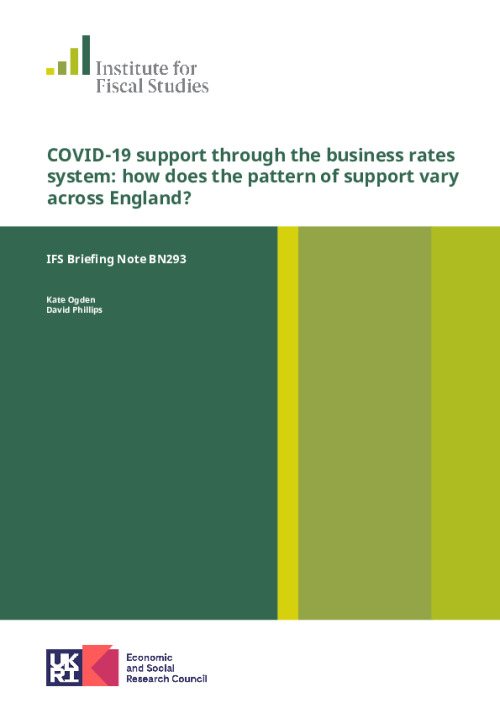Since March, governments across the world have introduced a range of policies to help support businesses, households and public services during the coronavirus crisis. Two of the largest schemes in England relate to the business rates system. First, the government is waiving business rates for the whole of 2020–21 for most businesses in the retail, hospitality and leisure sectors at a cost of around £10 billion. Second, grants of £10,000 and £25,000 are being made available to businesses, with eligibility depending on the rateable value of the properties they occupy, the sector they are in and a number of other factors. Local authorities have been provided with over £12 billion to fund these grants. Similar schemes operate in Scotland, Wales and Northern Ireland, albeit with some differences in eligibility rules.
These schemes and their design and implementation matter. They have been put in place to help otherwise viable businesses survive the coronavirus crisis, enabling a faster and fuller economic recovery. Differences in the degree of support provided to businesses in different sectors can potentially be justified by the uneven impacts of the crisis on sales and profitability. However, sectoral and especially geographical differences in the levels and timeliness of support could also mean increased risk of business failure and slower recovery in certain parts of the country, with potentially long-term effects on employment and prosperity.
Grants, reliefs and rateable values
- Grant funding is focused on the retail, hospitality and leisure sectors. Most properties in these sectors are entitled to grants of £10,000 if their assessed annual rateable value is £15,000 or less, or £25,000 if it is £15,001 to £50,999. In contrast, properties in other sectors are only automatically entitled to grants of £10,000 if they are eligible for small business rate relief (SBRR): that is, their assessed rateable value is less than £15,000 and the business occupying them occupies little or no additional property. However, some small businesses whose property is excluded from these main schemes may be given discretionary grants by their local authority (LA).
- The support provided to the retail, hospitality and leisure sectors is highly non-linear with respect to rateable value, creating inequities and risking distortions to competition. For example, a property with a rateable value of £15,000 is eligible for total support of £17,485, while one with a rateable value of £15,001 is eligible for £32,485.50. In other words, an increase in rateable value of £1 is associated with a near-doubling of the amount of support. In contrast, the fact that properties with rateable values of £51,000 or above are ineligible for grants means support almost halves from £50,449 to £26,112 at that point. Such big discontinuities could have been avoided by tapering support, as is done with SBRR where the discount is gradually reduced from 100% to 0% for rateable values between £12,000 and £15,000.
- Differences in rateable values and sectoral composition mean the share of properties entitled to support varies significantly across the country. For example, while across England around 70% of non-domestic properties have a rateable value of £15,000 or below, making them potentially eligible for £10,000 grants, less than a third have values low enough in Kensington & Chelsea and Westminster, and less than a half do in four additional London boroughs as well as Cambridge and Oxford, reflecting high property prices. In contrast, over 80% of properties have a rateable value of £15,000 or less in 40 LA areas, concentrated in coastal areas and the North. The highest shares are Isles of Scilly (89%), Torridge in Devon (88%) and North Norfolk (87%).
- For the retail, hospitality and leisure sectors specifically, over 20% of properties in London have values too high to be eligible for grant funding, compared with less than 10% in the North, Midlands and South West of England. However, higher values also mean that a third of properties in these sectors in the capital could be entitled to grants of £25,000, compared with around one-sixth in the North, Midlands and South West. Differences can be even greater at the individual LA level: over half of such properties in the City of London, Kensington & Chelsea and Westminster are above the cut-off for any grant support, compared with less than 5% in 30 mostly rural LAs.
- One option to address this would be to set different grant eligibility thresholds for different regions of the country to reflect differences in rateable values. For example, ensuring the same proportion of properties in London were entitled to £10,000 and £25,000 grants as nationally would require an almost doubling of thresholds in London: from £15,000 to £29,250, and from £51,000 to £97,000. Separate thresholds for inner London would have to be around three times as high as the current national thresholds, and around four times the thresholds required in the North, Midlands and South West.
- Spending on rates relief for the retail, hospitality and leisure sectors is concentrated on the most expensive properties and in areas with higher rateable values. For example, the top 1% of properties are worth at least £420,000, meaning they are entitled to relief of at least £215,040. In contrast, the median property is worth just £8,900 and is entitled to £4,417, which may have already been covered by the existing SBRR scheme.
- The mean amount of relief being provided to properties is highest in areas with major retail centres, including parts of the North such as Cheshire West & Chester, Gateshead, Newcastle-upon-Tyne and Trafford. However, these figures can be affected by the value of a relatively small number of particularly large properties (such as department and major high-street stores). Areas with high median amounts of relief – which are not distorted by such outliers – are much more heavily concentrated in London and its environs where property values and rents are highest. Reliefs for properties in Westminster amount to £943 million, over 9% of the national total, reflecting the fact properties in this LA represent over 8% of all rateable value in the retail, hospitality and leisure sectors.
The grants paid out by local authorities
- Local authorities have identified 955,000 properties as being eligible for grant funding – 48% of all properties, and 67% of those whose sector and rateable value are such that they could potentially be eligible for a grant. In one in ten LAs, less than 57% of those potentially eligible actually are eligible, whereas in another one in ten LAs it is more than 76%. To some extent, this is driven by sectoral structures: more urban LAs with a high share of office and industrial occupiers – which need to be in receipt of SBRR to be eligible for grants – have lower rates of eligibility; in contrast, rural and coastal LAs with a high share of hospitality occupiers – which do not need to be in receipt of SBRR to be eligible – have higher rates of eligibility.
- Local authorities have so far paid out grants to 87% of properties they have deemed eligible for support, up from 73% at the start of May. In one in ten LAs this share is less than 81% and in another one in ten it is more than 96%, with only a slight narrowing in this gap during May. LAs where a larger number and proportion of properties have been identified as eligible for grants have been slower in paying out. LAs where a larger share of properties are in the industrial, utilities, warehousing or public sectors, or are in the retail, hospitality and leisure sectors but are likely to be ineligible (such as beach huts, moorings, parking and stables), have also been slower. However, even taken together, these factors explain only 25% of the variation in the proportion of grants paid out. This suggests that some LAs have been more cautious in authorising payments and/or had less capacity and/or been less efficient at making payments swiftly.
Government funding for the grant schemes
- One in five LAs will spend more than their initial allocations of funding from the government for the grant scheme if they eventually pay grants to all properties they have identified as eligible. These are concentrated in inner London and the Home Counties. Another one in four will spend less than their initial allocations, with a particular concentration on the coasts of the South East and East of England. These geographic patterns suggest systematic biases in the estimates of grant eligibility used by the government to allocate funding to councils. In particular, seven of the ten LAs that look set to spend the least of their allocation are the seven where beach huts make up more than 10% of properties. This suggests the Department for Business, Energy and Industrial Strategy (BEIS) did not account for such properties likely being ineligible due to the rules of the grant scheme when it made initial funding allocations.
- Those spending more than their initial allocation could have an aggregate ‘overspend’ of just over £200 million, based on the average grant payment per property so far, which BEIS has said it will cover in full with top-up funding. However, those LAs spending less could have an aggregate ‘underspend’ of more than £800 million, which the government has yet to confirm it will attempt to recover in full. This means the scheme could cost £600 million less than the government originally budgeted for.
- Part of the underspends will be recouped by making LAs with underspends pay for at least part of the cost of additional discretionary grants in their areas. This could amount to around £360 million of the total £617 million LAs will be allowed to spend on discretionary schemes. It will still leave LAs with around £460 million of unspent funding, with over one-fifth of this accounted for by just three coastal LAs: East Suffolk (£22 million), Bournemouth, Christchurch & Poole (£35 million) and Tendring (£43 million). Allowing LAs to keep such large sums would be inequitable, so plans to ‘claw back’ remaining unspent money should be confirmed, including the potential to recycle this for general-purpose funding for all LAs.











